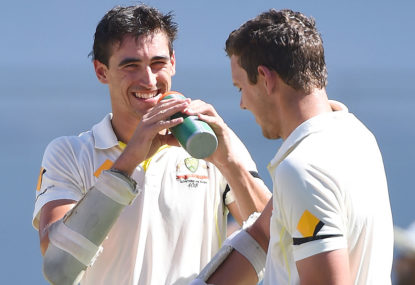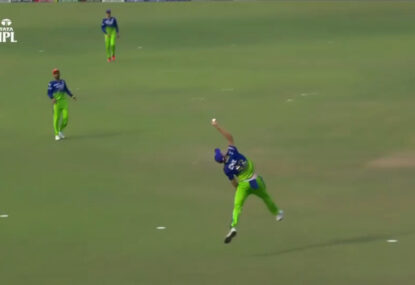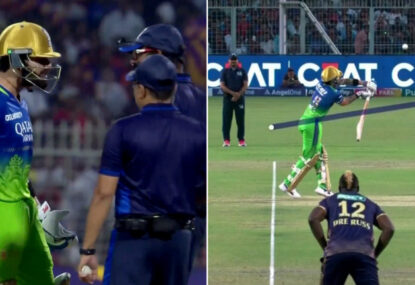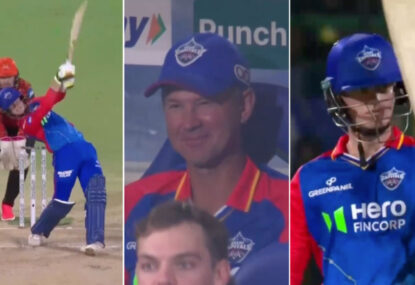India goes into the Cricket World Cup semi-final at the SCG unbeaten in seven starts, but they haven’t had to face Mitchell Starc. Today is their moment of truth.
With Starc using all his 197centimetre 92-kilogram frame to devastating effect, he’s captured 18 wickets in the tournament from only six games at a miserly 9.77 – far and away the best overall figures among the 14 countries.
The only two close to Starc are Black Cap Trent Boult with 21 wickets at 15.76 from eight games, and India’s Mohammed Shami with 17 at 13.29 from six.
They are 1-2-3 as the tournament’s most successful bowlers.
But Starc is the ‘Exterminator’, bowling around the 150km/h from the ‘third floor’, using his height and pace in tandem.
After taking 0-40 off seven in the Tri-Nations final against England, where he copped a bit of tap, Starc needed to kick-start his World Cup campaign, again against England.
And that’s exactly what he did.
His six-match stats – 2-47 off nine (England), 6-28 off nine (NZ), 2-18 off six (Afghanistan), 2-29 off 8.2 (Sri Lanka), 4-14 off 4.4 (Scotland), and 2-40 off 10 against Pakistan in the quarters.
Economy rate – 3.74.
But don’t overlook Shami, one of the major reasons why India has captured all 70 opposition wickets in their seven games, which is an unheard of stat.
But India hasn’t come up against an Australian batting order that can vary from explosive to erratic.
On the other side of the coin, ignore all India’s performances this summer in the Tests and one-dayers, they have been playing this World Cup as you’d expect the defending champions to play – unbeaten.
Comparing the attacks for the semi-final, Australia has a huge edge thanks to Starc, which will be magnified if Mitchell Johnson can regain his mojo of old, and start ripping and tearing like his left-arm partner.
Johnson’s 10 wickets at 24.60 aren’t the real deal, even though the only Australian bowler who has a better average is Josh Hazlewood, whose six wickets have cost 17.50.
James Faulkner’s four wickets have cost 25.50, Glenn Maxwell’s five at 32.60, and Shane Watson’s two scalps have been very costly at 59.50 apiece, and all three will have to play a vital role to cover the 50 overs.
Apart from Shami, India’s next best have been Umesh Yadav with 14 at 17.78, Mohit Sharma with 11 at 21.72, and Ravi Jadeja’s nine at 33.44.
Apart from Starc being the obvious spearhead, the Australian batting stacks up well if the tournament stats are to be a genuine guide.
1. David Warner 296 runs, top score 178, average 57.60 versus Rohit Sharma’s 296 – 137 – 49.33.
Verdict: Australia
2. Aaron Finch 199 – 135 – 33.16 versus Shikhar Dhawan 367 – 137 – 52.42.
Verdict: India
3. Steve Smith 241 – 95 – 48.20 versus Virat Kohli 304 -107 – 60.80.
Verdict: India
4. Michael Clarke 135 – 68 – 33.75 versus Ajinkya Rahane 164 – 79 – 32.80.
Verdict: Square
5. Shane Watson 178 – 67 – 44.50 versus Suresh Raina 277 – 110* – 69.25.
Verdict: India
6. Glenn Maxwell 301 – 102 – 75.25 versus MS Dhoni 172 – 85* – 57.33.
Verdict: Australia
On that basis, India hold the batting order advantage in three spots, Australia two, with one squared away. But where Australia will have a huge advantage will be the lower order.
Brad Haddin’s scored four Test tons, and two in ODIs, Faulkner one ODI ton, Johnson’s scored a Test ton, and Starc a Test 99, so there’s plenty of batting talent down below if the top order turn erratic.
India doesn’t have that lower order luxury.
Jadeja has scored 10 half-centuries in 80 digs, Ashwin two Test tons, Shami one half-century in 39 digs, Sharma has a top score of eight in 19 ODIs, while Yadav’s top score is 30 in 29 international digs.
My prediction is Australia to win in what promises to be another cracker of a game, maybe not with a six off the second last ball as in the first semi-final, but at least very competitive from the first ball to the last.




































































































